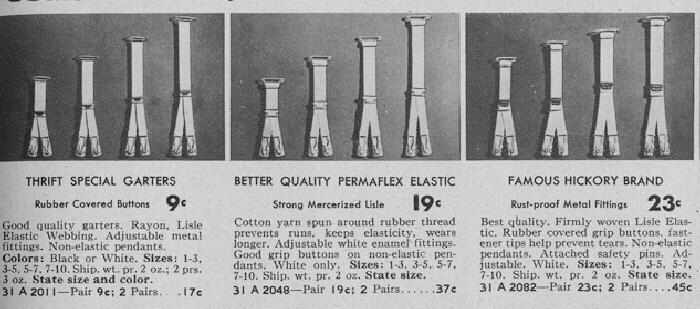
U.S. Catalogs and Advertisements: Ward's Garters

Figure 1.--Wards offered three types of pin-on hose supporters referred to as garters. Wards offered three types done in different sizes from 1-10 which I assume means age. The different grades seem to vary in elasticity and quality of the metal used. Wards continued to offer children's supporters in three different grades and prices, which indicates the high demand and the range of economic classes that bought them.
|
Wards offered three types of pin-on hose supporters referred to as garters. Wards offered three types done in different sizes from 1-10 which I assume means age. The different grades seem to vary in elasticity and quality of the metal used. Wards continued to offer children's supporters in three different grades and prices, which indicates the high demand and the range of economic classes that bought them. All three were made in the same size range to age 10 years.
Garter or gartier is of historic origins. It appears to have entered the English language from Old North French in the early 14th century. The word was derived for the French word describing the bend of the knee. It came to be the symbol for an English knightly order--the Order of the Garter. The garter is a device to hold up hosiery. They were worn by both adults and children. There are two basic types. One was an elastic band worn around the leg. This type was commonly used by children to hold up kneesocks. Scouts were noted for adding a colored tab to the garter. It was commonly used before kneesocks with elasticised tops became popular. Another type was an elastic strap suspended from an undergarment. These were worn by both boys and girls to hold up long stockings.
Thrift Special Garters
The Wards ad copy read, "Rubber Covered Buttons. 9 cents.
Good quality garters. Rayon, Lisle Elastic Webbing. Non-elastic
pendants. Colors: Black or White. Sizes 1-3, 3-5, 5-7, 7-10. Ship.
wt. pr. 2 oz; 2 prs 3 oz. State size and color. 31 A 2011--Pair 9 c.;
2 Pairs 17 c." Note that these garters were only partially elasticized. That is one reason that they were cheaper.
Better Quality Permaflex Elastic
The Wards ad copy read, "Strong Mercerized Lisle. 19 cents.
Cotton yarn spun around rubber thread prevents runs, keeps elasticity,
wears longer. Adjustable white enamel fittings. Good grip buttons on
non-elastic pendants. White only. Sizes 1-3, 3-5, 5-7, 7-10. Ship.
wt. pr. 2 oz. State size. 31 A 2011--Pair 19 c.; 2 Pairs 37 c."
Famous Hickory Brand
The Wards ad copy read, "Rust-proof Metal Fittings. 23 cents.
Best quality. Firmly woven Lisle Elastic. Rubber covered grip
buttons, fastener tips help prevent tears. Non-ealstic pendants.
Attached safety pins. Adjustable. White. Sizes: 1-3, 3-5, 5-7, 7-10.
Ship wt., pr 2 oz. State size. 31 A 2082--Pair 23 c; 2 Paris 45 c." We find russt proof fittings rather a strange advertising ploy. We rather thought that these garters were worn for relatively short periods. Why would they rust?
HBC

Navigate the Boys' Historical Clothing catalog/magazine pages:
[Return to the Main Wards 1941-42 support page]
[Return to the Main American mail order 1941 page]
[Main photo/publishing page]
[Store catalogs]
[Fashion magazines]
Navigate the Boys' Historical Clothing Web Site:
[Introduction]
[Activities]
[Biographies]
[Chronology]
[Clothing styles]
[Countries]
[Bibliographies]
[Contributions]
[FAQs]
[Glossary]
[Satellite sites]
[Tools]
[Boys' Clothing Home]
Navigate the Boys' Historical Clothing Web Site:
[Sailor suits]
[Sailor hats]
[Eton suits]
[Knicketrs]
[Short pants]
[Rompers]
[Long stockings]
[Stocking supporters]
[Underwear]
[Waists]
Created: 2:55 AM 3/19/2006
Last updated: 2:55 AM 3/19/2006



